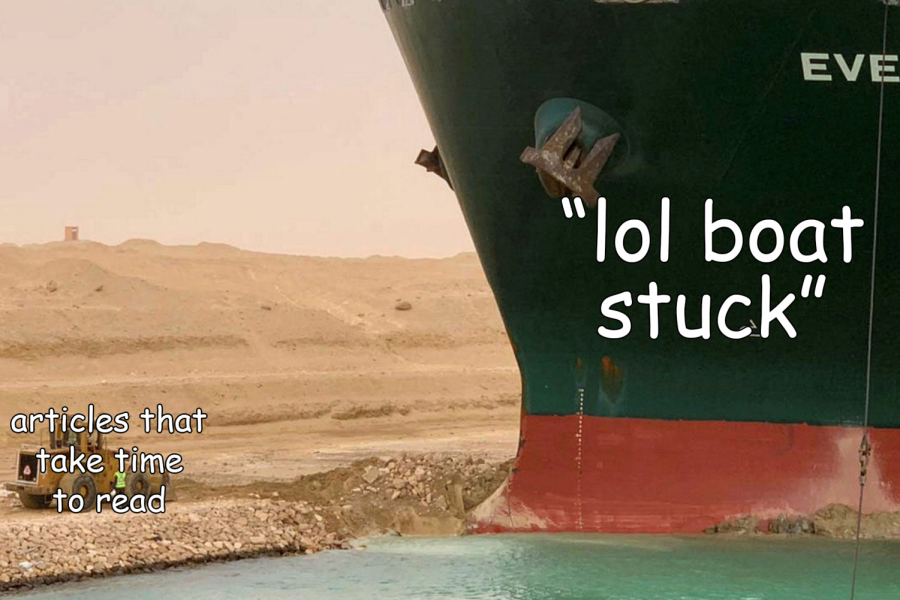The Suez Canal and meme journalism
More people found out about the Suez Canal from memes than from news sites. What does this mean for the future of journalism?
Instead of pondering the lasting effects the blockage could cause the economy, most people reacted with unfunny jokes such as this.
On any give day, about $3 billion worth of cargo passes through Egypt’s Suez Canal. Although it is not a popular route for the transportation of oil, a pretty substantial amount of business relies on the canal.
So, when the Ever Given got stuck in the canal from March 23-29, it was a pretty big hindrance to the corporations of the world. During the span of just one week, the Ever Given managed to back up 450 ships, with the last ships not being able to get through until April 2, a whole ten days after the initial blockage.
That means, the Ever Given getting stuck could have cost the corporations of the world up to $30 billion worth of transactions, not to mention the $1 billion worth of damages it caused to the Egyptian shores.
This seems like some pretty serious news, no? In fact the situation is so serious, Egypt is not letting the vessel leave its waters until the ship’s parent company pays for damages. Despite this, the majority of people found out about this incident from memes.
The first photos of the ship came from random passers-by, and the internet was quick to take advantage, pumping out memes before most major media outlets were able to create stories. Because of this, people did not find out about the Suez Canal from CNN, they found out from their unfunny aunt’s Twitter.
Although this may seem harmless at first, events like this could set a precedent for the way people view news in the digital age.
First, people are dumb. Most people would rather look at a picture and think “lol boat stuck” than read a whole article explaining how and why this ship got stuck.

Take, for instance, the vice-presidential debate. People could not give two hoots about either candidates’ points. Instead the reaction was “haha there’s a fly.”
Also, memes (or pictures in general) are easier consume than traditional news media. People are lazy. They would much rather look at a picture for a couple of seconds than take all the time and effort to read an article.
They also take much less time to create. They can get pumped out faster than news stories, so they will be seen before news stories and seen by more people.
What does this mean for the future of news and journalism? There are a couple ways news media sites could respond to this.
They could go for quantity over quality, releasing as many stories as they can as quick as possible. This strategy, however, would most likely mean short stories with a sensationalized headline that say next to nothing. So, basically all journalism would look like the garbage featured in the Purple Quill.

They could succumb to the masses and start making memes themselves. Similar to the last option, there is a zero percent chance these memes will be funny, because the only thing worse than a person who makes memes is a company that makes memes.
Finally, they could just give up. Nobody cares about news anymore. People would rather look at one picture and one headline and let Twitter tell them what to think about it.
Events like the Suez Canal fiasco could set a dangerous precedent for the way we receive and process our news. As people’s willingness to read news stories decreases, so to does their knowledge about current events. Yet, in this age of mass disinformation and fake news, people would rather get their information from memes.















